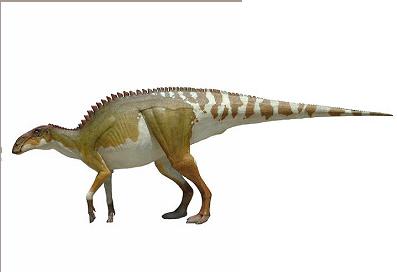Brachylophosaurus (brak-ee-LOH-fo-sawr-us) meaning "short-crested lizard" (Greek brachy = short + lophos = crest + sauros = lizard, referring to its small crest) was a mid-sized member of the hadrosaurid family of dinosaurs. It is known from several skeletons and bonebed material from the Judith River Formation of Montana and the Oldman Formation of Alberta (Weishampel and Horner, 1990), so roughly 75 million years old.
It was first described by C.M. Sternberg in 1953, on a skull and partial skeleton at first thought to belong to Gryposaurus (or Kritosaurus as it was known at the time). This animal is notable for its bony crest, which forms a flat, paddle-like plate over the top of the skull. Some researchers have suggested it was used for pushing contests (Weishampel and Horner, 1990), but it may not have been strong enough for this. Also notable are the unusually long forelimbs.
Jack Horner described a second species in 1988 from Montana, B. goodwini, but later work indicated that the differences were probably not enough to justify the second species (see for example Prieto-Marquez, 2005).
Recent Discoveries
In 1994, Paleontologist Nate Murphy discovered an immaculate, complete and uncrushed bracylophosaur skeleton which he dubbed 'Elvis'.
Incredibly, more impressive finds lay ahead for Nate and his team from the Judith River Dinosaur Institute.
In 2000, Leonardo, a fully articulated and partially mummified skeleton of a subadult brachylophosaur was discovered (Murphy et al., 2002). It is considered one of the most spectacular dinosaur finds ever, and was included in the Guinness Book of World Records.
They subsequently excavated 'Roberta,' an almost complete gracile skeleton, and 'Peanut', a partially preserved juvenile with some skin impressions.
It was first described by C.M. Sternberg in 1953, on a skull and partial skeleton at first thought to belong to Gryposaurus (or Kritosaurus as it was known at the time). This animal is notable for its bony crest, which forms a flat, paddle-like plate over the top of the skull. Some researchers have suggested it was used for pushing contests (Weishampel and Horner, 1990), but it may not have been strong enough for this. Also notable are the unusually long forelimbs.
Jack Horner described a second species in 1988 from Montana, B. goodwini, but later work indicated that the differences were probably not enough to justify the second species (see for example Prieto-Marquez, 2005).
Recent Discoveries
In 1994, Paleontologist Nate Murphy discovered an immaculate, complete and uncrushed bracylophosaur skeleton which he dubbed 'Elvis'.
Incredibly, more impressive finds lay ahead for Nate and his team from the Judith River Dinosaur Institute.
In 2000, Leonardo, a fully articulated and partially mummified skeleton of a subadult brachylophosaur was discovered (Murphy et al., 2002). It is considered one of the most spectacular dinosaur finds ever, and was included in the Guinness Book of World Records.
They subsequently excavated 'Roberta,' an almost complete gracile skeleton, and 'Peanut', a partially preserved juvenile with some skin impressions.
click images for larger views

[Home]
[News] [Life-Size Sculptures] [Model Kits] [Wildlife Collection]
[Complete Catalog]
[About Us] [Contact Us]
[Frequent Questions] [The Studio At Work] [Links] [Privacy Policy] [Terms of Use]
mail@cmstudio.com
© 2017 CM Studio
All Rights Reserved
CM Studio 100 West Central Avenue Benld, Illinois 62009
[News] [Life-Size Sculptures] [Model Kits] [Wildlife Collection]
[Complete Catalog]
[About Us] [Contact Us]
[Frequent Questions] [The Studio At Work] [Links] [Privacy Policy] [Terms of Use]
mail@cmstudio.com
© 2017 CM Studio
All Rights Reserved
CM Studio 100 West Central Avenue Benld, Illinois 62009



